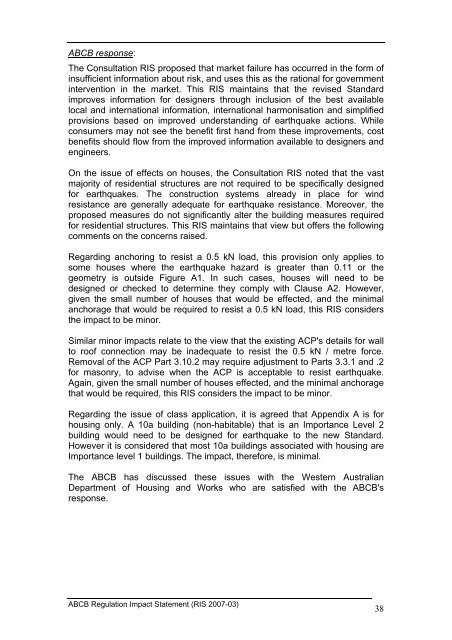PDF | 2 MB - Australian Building Codes Board
PDF | 2 MB - Australian Building Codes Board
PDF | 2 MB - Australian Building Codes Board
Create successful ePaper yourself
Turn your PDF publications into a flip-book with our unique Google optimized e-Paper software.
ABCB response:<br />
The Consultation RIS proposed that market failure has occurred in the form of<br />
insufficient information about risk, and uses this as the rational for government<br />
intervention in the market. This RIS maintains that the revised Standard<br />
improves information for designers through inclusion of the best available<br />
local and international information, international harmonisation and simplified<br />
provisions based on improved understanding of earthquake actions. While<br />
consumers may not see the benefit first hand from these improvements, cost<br />
benefits should flow from the improved information available to designers and<br />
engineers.<br />
On the issue of effects on houses, the Consultation RIS noted that the vast<br />
majority of residential structures are not required to be specifically designed<br />
for earthquakes. The construction systems already in place for wind<br />
resistance are generally adequate for earthquake resistance. Moreover, the<br />
proposed measures do not significantly alter the building measures required<br />
for residential structures. This RIS maintains that view but offers the following<br />
comments on the concerns raised.<br />
Regarding anchoring to resist a 0.5 kN load, this provision only applies to<br />
some houses where the earthquake hazard is greater than 0.11 or the<br />
geometry is outside Figure A1. In such cases, houses will need to be<br />
designed or checked to determine they comply with Clause A2. However,<br />
given the small number of houses that would be effected, and the minimal<br />
anchorage that would be required to resist a 0.5 kN load, this RIS considers<br />
the impact to be minor.<br />
Similar minor impacts relate to the view that the existing ACP's details for wall<br />
to roof connection may be inadequate to resist the 0.5 kN / metre force.<br />
Removal of the ACP Part 3.10.2 may require adjustment to Parts 3.3.1 and .2<br />
for masonry, to advise when the ACP is acceptable to resist earthquake.<br />
Again, given the small number of houses effected, and the minimal anchorage<br />
that would be required, this RIS considers the impact to be minor.<br />
Regarding the issue of class application, it is agreed that Appendix A is for<br />
housing only. A 10a building (non-habitable) that is an Importance Level 2<br />
building would need to be designed for earthquake to the new Standard.<br />
However it is considered that most 10a buildings associated with housing are<br />
Importance level 1 buildings. The impact, therefore, is minimal.<br />
The ABCB has discussed these issues with the Western <strong>Australian</strong><br />
Department of Housing and Works who are satisfied with the ABCB's<br />
response.<br />
ABCB Regulation Impact Statement (RIS 2007-03)<br />
38
















